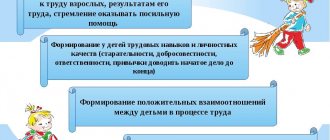MAGAZINE Preschooler.RF
Round table with parents on the topic: “Labor education in the family.” Topic: “How to instill hard work in a child?”Goal: developing the competence of parents in the issue of labor education of children.
Tasks:
- introduce parents to the peculiarities of labor education of children in the family
- characterize the content of a child’s interest in work, taking into account age characteristics in the process of labor education in the family
- cultivate positive relationships in the process of work between children and adults.
Progress of the event:
Introductory part
Hello, dear parents! Thank you for taking the opportunity to come to today's meeting.
And I want to start our communication with the memories of the serf peasant Fyodor Bobkov. Here's what he wrote about his childhood:
“My participation in the work consisted of winding threads on small bobbins for weaving calico. During the summer, my responsibility was to babysit my brother and sister, who were younger than me. During the harvest, I stayed alone with them in the house. I didn’t bother with them very much - I gave Petrushka a piece of bread, Katya a pacifier and ran off to play with the boys, completely forgetting about my pets. Occasionally our neighbor, Aunt Matryona, would shout at me for leaving the children unattended, then I would return home, shove a piece of bread into one’s mouth, a pacifier into another’s mouth, and run away again. Until winter I ran barefoot, and in winter I walked in bast shoes.” .
It was not without reason that I read this excerpt from my memoirs. Each of us, listening to this passage, was mentally transported to those distant times. They introduced this little boy and drew a parallel with children today.
Perhaps there was some kind of special education system for peasant children, but most of them grew up in their natural environment and learned everything new themselves, getting their bearings.
Much has changed in our lives and in the lives of our children. The school curriculum has become more complicated, and it has become more difficult to study. So parents make a “sacrifice”: they take on all the housework themselves.
We want our children to live better than we do, and we free them from all workload, from all responsibilities, for some reason thinking that living “better” means living without doing anything.
And today we have gathered together to understand this difficult issue.
I propose to split into two groups. We will be equally interested to hear the opinions of fathers and mothers. In the first group we will only have mothers, and the second group will consist of fathers.
And so, we begin.
Practical part:
1. WHAT DOES IT MEAN to prepare a child for life? What is the main guarantee that this life, so dear to us, will be lived beautifully, brightly, and profitably? We will probably not be mistaken if we say: the main thing is to teach people to love work and find a source of joy in it.
To begin with, I will ask the members of both teams to define the concept of “hard work” . What do you think the concept of hard work includes?
- This is the moral quality of a child’s personality, manifested in his awareness, responsibility, satisfaction with the work process, the child’s interest in achieving useful results of his work, and a positive attitude towards the work of an adult.
— Hard work is a character trait that consists of a person’s positive attitude towards the process of work.
(task analysis)
2. And now I propose to play the “Yes - No” . There are cards with questions on the tray; you need to divide these cards into three groups. The first group is those tasks that your child most often performs at home. The second group is those tasks that the child rarely performs. And third, these are those instructions that the child does not complete at all. At the end of the game we will analyze the result.
List of instructions:
- Assist parents in cleaning the apartment.
- Cleans up his desk and his room.
- Take care of your younger brother or sister.
- He washes his small things.
- Washes tea (or other) dishes.
- Keeps shoes clean.
- Takes out the trash.
- Feeds pets, birds, aquarium fish.
- Walks with a dog, cat.
- Goes to the store independently (for bread, milk, etc.).
- Takes care of plants.
- Helps with food preparation (washes vegetables for salad, rolls out dough)
- Sets the table and clears the table.
- Glues books and board game boxes.
- Performs feasible work on the plot.
- Makes his bed.
(task analysis)
What kind of help with housework can preschool children provide? The range is quite wide. Remember, when giving instructions to a child, it is necessary to clearly explain what is being done, why, and why. The child needs to know why he needs to perform certain tasks and what result should be achieved. This is the only way for preschoolers to form an idea of the need for these actions.
3. Among modern scientists there is an opinion that labor should not be divided into “male” and “female” . Do you agree with this opinion? If not, why not?
Parents should know that both girls and boys need to be taught to do all types of homework equally. It is necessary that boys and girls equally learn to do everything necessary around the house and not consider doing this work as something unworthy of themselves. Anyone who has observed children knows that in early childhood, boys are just as willing as girls to help their mother cook, wash dishes, and do any housework. But usually in families, from a very early age, differences between boys and girls begin to show.
I will ask the team of mothers to describe the work activities of the boys, and let the fathers determine work assignments for the girls.
Labor education of girls
Girls need to be involved in household work: taught to clean the house, do laundry, cook simple meals, and set the table. Such activities should be unobtrusive and properly organized so that the baby becomes more and more willing to help her mother. The daughter needs to understand that they need her help. As you grow older, you need to add more complex tasks: handicrafts, caring for the younger ones. Working together, mother and daughter develop mutual understanding. In the future, all this will have a positive impact on caring for elderly parents.
Labor education of boys
The best example for a son is his father. If dad sits on the couch all day long and does not help his wife, then most likely the boy will not grow up to be a hard worker.
Depending on the age of the baby, dad can assign various work activities: helping during the repair of any items, giving tools, assisting with work in the garden or garage. A common cause promotes rapprochement and improvement of relationships. Repairing some simple household appliances can be turned into an interesting activity, stimulating the child’s greater interest.
(task analysis)
4. Each team has a list of ways to involve a child in work. Your task is to rank these methods in your opinion according to the principle of effectiveness. Which of these methods is the most effective in your opinion and why?
- Request
- Compulsion
- Promotion
- OK
- Gratitude
- Competition
- Punishment
A request is the best and gentlest way of addressing, but you should not abuse the request. The request form is best used in cases where you know well that the child will gladly fulfill your request. If you have any doubt about this, use the form of an ordinary order, calm, confident, businesslike.
Coercion can be different - from a simple repetition of an order to a sharp and demanding repetition. In any case, you should never resort to physical coercion, since it brings the least benefit and causes the child to have an aversion to the work task.
Encouragement - approval, gratitude, awards expressing the advantages of evaluating the child’s activities.
Approval is a simple type of encouragement.
Gratitude is on a higher level.
Competition is a method of directing the natural need for competition and priority in cultivating the qualities needed by a person and society. Efficiency increases if the tasks are determined by the children themselves.
Punishment – this issue is still debated. It should prevent unwanted actions, slow them down, and cause a feeling of guilt towards oneself and other people.
The biggest challenge for parents is how to deal with so-called lazy children. Laziness develops in a child due to improper upbringing, when from a very young age parents do not instill in the child energy, do not teach him to overcome obstacles, do not arouse in him interest in the family household, do not instill in him the habit of work and the habits of those pleasures that work always delivers. There is only one way to combat laziness: gradually drawing the child into the field of work, slowly arousing his interest in work.
4. So, in a family, work for children should be feasible. A child may have household chores that he performs constantly. For example, taking care of your shoes, clothes, toys. At an older age, the child can already wash his own dishes, care for pets, water indoor plants, etc.
You have cards on your tables with various situations that can happen in the family. We need to discuss them and, if possible, formulate rules that will help raise a hardworking child.
A) The child does not have time to complete your instructions on time, because he is too slow and clumsy in his movements. How to proceed?
(Give extra time. You can, of course, peacefully offer your help: “Well, how are you doing? Let’s go together, do you want?” But if you can be patient and allow your son or daughter to finish what they started, this is more correct.)
B) The child completed the assignment: he cleaned his room. Clearly he tried. To thank or not to thank? And how to thank?
(A kind word from parents is an important reward. You need to show that you appreciate his work. After all, cooking dinner for you is a common thing, but it’s nice to hear praise. Let him feel that you consider him an adult.)
(task analysis)
5. Labor education of preschoolers is carried out using a number of means: children’s own labor activity, familiarization with the work of adults, artistic means.
Which of the three is the leading remedy and why?
Labor activity is the leading means of labor education. Children's own labor activity is a necessary means of labor education.
Familiarization with the work of adults. This tool allows you to expand the child’s understanding of the content of human activity, the social significance of work, and the attitude towards work.
Artistic media: fiction, music, visual arts. With the help of this group of tools, children form ideas about the content of work, about people’s attitude towards work, about how others evaluate the work of other people, etc.
Homework
Dear parents, at the end of our meeting I would like to ask you to participate in the creation of the book “My Family’s Labor Traditions” . Write about your family work traditions. What work traditions do you have in your family? Do children need them? Place photographs and drawings about your family work on the pages. Share your experience and interesting information. We will put all the pages into our “work” book. We will update it with interesting work events. This will be your homework
Final part:
Let's summarize our meeting. Let's answer the questions that we posed at the beginning of our conversation: Why is it necessary to instill a love of work in children?
To the question: “How to educate through labor?” We also tried to answer. The following were presented to your attention and for discussion: forms, methods, principles, conditions, rules for organizing labor activity. I hope that today's meeting helped you understand the very important issues of labor education. And I really hope that many of you will take advantage of our tips and recommendations.
— Once, one restless mother asked the great teacher A. S. Makarenko:
— “At what age should you start raising a child if he is now 9 months old?
- You are exactly 9 months late! - answered Makarenko.
I would like to wish all of us that we would never be late in matters of education.
Thank you all for your participation. See you again!
Literature:
- A. S. Makarenko. "Family and raising children" . Tutorial. M. Pedagogy, 1984.
- L. A. Kulik. Family education: Textbook, M. Education, 2003.
- Pashkov A.G. Labor as a means of education//Pedagogy, 1992, No. 7-8.
- Kaleidoscope of parent meetings. Methodological developments. Issue 1. / E.N. Stepanova - M.: Creative Center, 2001.
- Dialogues about education. / Book for parents. - M.: Pedagogy, 1985.
| Next > |
Topics of labor education events in schools and kindergartens
Labor is an integral part of human life, which is why labor education should also be constant and ongoing. It is not customary to devote specific hours to it (like music, physical education). Labor is one of the important components of educational work in state educational institutions. Educational work activities are planned by the teacher, have goals, objectives, and methods. In addition, teachers actively use the event as an effective form of education. Labor education activities are carried out at the school (kindergarten) and outside its walls.
The topics of labor education events are not chosen by chance. When choosing a topic, the teacher is guided by:
- The assigned task;
- age of children;
- venue;
- ultimate goal.
Sample topics for labor education activities in secondary schools
| Event form | Subject |
| Cool watch. Conversations | 1. “My house - I’ll put it in order” |
| 2. “Nothing comes without effort” | |
| 3. “My responsibilities in the family” (with students in grades 1-4) | |
| 4. “The role of knowledge in choosing a profession” | |
| 5. “The world of professions and your place in it” | |
| 6. “The influence of temperament on the choice of profession” | |
| 7. “The ability to work is the main quality of a person” (with students in grades 5-8) | |
| 8. “First steps when applying for a job” | |
| 9. “Youth Labor Rights” | |
| 10. “Personal and public in choice” | |
| 11. “The importance of professional choice in later life” for 9th grade students | |
| Parent meetings | 1. “Components of choosing a profession” |
| 2. “The roads our children choose” | |
| 3. “Cultivating hard work in the family” | |
| 4. How to raise an assistant?” (in primary school) | |
| 5. “Introducing younger teenagers to useful work.” | |
| Consultations for parents | 1. “What kind of work can you do with your child at home” |
| 2. “Mistakes and difficulties in choosing a profession” | |
| 3. “Assessing a child’s ability to choose a profession” | |
| 4. “Secondary educational institutions and universities in Moscow and the Moscow region and conditions for admission to them” (example) | |
| Conducting competitions, months, decades | 1. “The cleanest school” |
| 2. “The cleanest class” | |
| 3. “The most original flowerbed” | |
| Design of information stands inside a secondary school | 1. “Your professional career” |
| 2. “In the world of professions” | |
| 3. “To help graduates” | |
| 4. “Choose your profession” |
Conversations on the topic of labor education
* Analysis of the regional labor market; * Questioning employers to identify their requirements for graduates; * Conversations on the topics: “Are you satisfied with the choice of your profession”; “Educational activities and continuity of vocational education”; * Improvement of the territory of the educational institution; * Familiarity with production at the workplace; * Temporary and permanent household duties; * Inclusion of a student in a group or team of people working together; * Meetings with graduates of different years; * Interaction with enterprises and organizations of the region, regional and local administrations; * Meetings with social partners; * Meetings with representatives of labor dynasties, graduates, labor veterans, business representatives; * Meetings with employers; * Fulfilling orders under contracts in college workshops; * Meetings with employees of the Employment Center; * Meetings with practical workers; Meetings with managers and specialists of enterprises; * Exhibition of creative works of students and teachers; * Additional financial incentives for students who have high academic performance, research work, and activists; * Disputes; * Business games “What do I know about my profession?”; * Decades of knowledge; * Duty in educational institutions; * Familiarity with the requirements of employers; * Acquaintance with new technologies; * Study of the labor market; * Games: “Lucky Chance”, “Tournament of Experts”, “Own Game”; * Production of visual and poster materials in college classrooms and workshops; * Round tables “How to find a job”; * Competitions by profession “Best in Profession”; * Wall printing competitions; * Competition for the best group website and personal page; * Class hours: “First steps when getting a job”, “Labor rights of young people”, “Personal and social in choosing a profession...”, “The importance of professional choice in later life”; “What are professional ethics and the personal and professional growth of a student” ;"What is the secret of success"; * Events: “Specialist of the 21st Century”, “Initiation as a Student”, “Evening with Alumni”; * Organization of work in hobby groups; * Training in technologies and work practices; * Determination of specific job responsibilities; * Providing work with the necessary material resources; * Providing temporary employment for students; * Organization and holding of mass cleanup days; * Design and equipment of workshops and laboratories; * Organization of additional professional education on a paid basis for college students; * Organization of industrial training in the summer at enterprises; * Olympics, quizzes; * Organization of practical training for students at enterprises and workshops * of an educational institution; * Greening streets in populated areas; * Maintaining the sanitary condition of classrooms; * Internship at enterprises; * Visiting territorial fairs of educational and workplaces; * Visiting professional skills competitions, thematic exhibitions on professions in museums, exhibition halls; * Carrying out events glorifying family dynasties and family traditions; * Preparation of didactic material, visual aids; * Conducting individual lessons with students, involving them in creative activities; * Representing your profession at a competition; * Repair of educational visual aids, books in the library, furniture and equipment; * Parent meetings “Labor education”; * Work of technical creativity circles; * Work of the Center for the Promotion of Student Employment and Graduate Employment; * Systematic participation in socially useful work; * Essays; * Collecting information about new products in the profession, setting up stands in workshops and offices; * Wall newspapers and stand design for professional holidays; * Subbotniks, general cleaning, furniture repairs; * Student construction teams; * Student scientific and practical conferences; * Creating an external environment conducive to work; * Creation of an information system that provides graduates and students with data on the state of the labor market; * Thematic classroom hours; * Creative exhibitions, competitions and competitions, assessment of their quality; * Participation in open events to prepare for military service; * Participation in the All-Russian competition of scientific and technical creativity of youth; * Participation of students in the summer work semester; * Strengthening the material and technical base of the college by students; * Participation of social partners in the professional development of students; * Participation of employers in the final certification; * Participation of employers in professional skills competitions; * Formation of student teams; * Excursions to enterprises; * Excursions to the facilities of agricultural enterprises, to enterprises according to the profile of professions and specialties; * Excursions to enterprises; * Excursions to enterprises of the city and region; * Legal education of students.
vote
Article rating
Labor education activities
“Why are events needed in such a not very joyful activity as labor education?” – this question is sometimes asked by students of pedagogical colleges, as well as young parents. First, tell yourself why events are needed at all? Why do kindergartens and schools spend extra time (often more money) on organizing themed parties, conversations, excursions, parents’ living rooms and other interesting moments? What is their purpose?
Educational activities would be very boring if not for the variety of methods and forms. The form of leisure is one of the most effective. In an informal setting, with a positive attitude, often with music and laughter, the most important pedagogical tasks are solved , the materials learned are consolidated, useful experience is gained, and the ties between the educational institution and families are strengthened.
Labor education games for children 4-6 years old
| Type of game | Game theme. Her goal |
| Didactic game | "Name your profession" |
Goal: to learn to correctly name a person’s profession based on the types of machines driven by that person.
Game "Guess what I'm doing?"
Target. Expand children's understanding of work activities. Develop attention.
Progress of the game . The teacher and children join hands and stand in a circle. A child comes to the center of the circle. The musical director plays. Everyone walks in a circle and sings: We’re walking in a circle, we’ll sing a song for you. We don’t know what you’re doing, we’ll have a look and guess. The child imitates labor actions with movements, but if possible, he conveys them with sounds. For example, he cleans the floor with a vacuum cleaner, hammers a nail, saws, drives a car, washes, chops wood, grates, etc. Children guess the actions.





